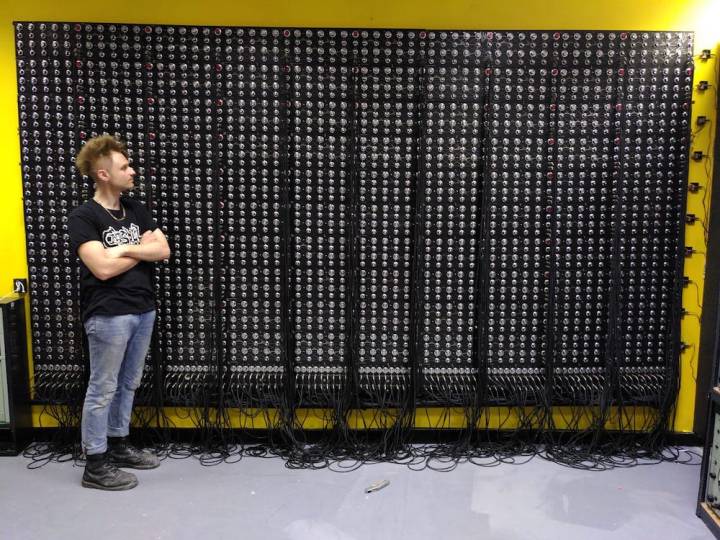
When the legendary music producer Phil Spector was searching for a term to describe a certain kind of dense orchestral arrangement, made possible through breakthroughs in studio recording, he coined the phrase “wall of sound.” The wall was, of course, a metaphor for a sound that was so rich, so full-bodied that it seemed to have a physical weight. It was not to be taken literally.
Sam Battle, a popular YouTuber who posts under the name Look Mum No Computer, has built a literal wall. And it’s both awesome and a bit scary.
Pitched (literally) somewhere between that iconic THX effect played before movies, an eardrum-popping torture instrument, and a Chris Nolan score generator, the KiloDrone is an enormous collection of analog drone synths.
“I love when ideas are massively time-intensive but reasonably stupid. It means that it’s likely you may be the only person crazy or dumb enough to even try doing it.”
Analog synthesizers make noise by manipulating electrical voltages. This voltage is shaped by an oscillator so that it produces a steady pitch at a certain frequency. This determines a basic waveform that the synthesizer processes. The frequency of the wave determines the pitch of the sound. The amplitude controls the volume. As its name implies, the KiloDrone has a total of 1,000 oscillators. These are divided up into 100 modules, each one containing 10 such oscillators. Each oscillator features a knob for changing the frequency and amplitude of the wave. The results are one of the most impressive and unusual synths you’ll find anywhere. And that includes the ambitiously weird Furby orchestra that Battle built previously.
“The KiloDrone is a machine that measures four meters by three meters, [that’s mounted to a wall],” the U.K.-based “synth scientist” Battle told Digital Trends. “It houses 1,000 oscillators that [have] separately controlled pitch and volume, but the whole pitch can be controlled together as well.”
‘A bit overkill’
Battle described the creation, which is made from around 30,000 electronic components, as “a bit overkill.” It is, of course, a bit of an overkill year: enough to push anyone to their limits. “I built it during lockdown as I wanted a big challenge to do on those long nights stuck at home,” Battle explained. “It was a slow start because I had to prototype, and kept messing up and coming up [against] problems. But after a [I] managed to get it going.”
The project is a spiritual successor to a similar, but much smaller, 100 oscillator version Battle built in 2017. (Who would have thought at the time that a 100 oscillator MegaDrone would one day turn out to be comparatively undersized?)
“It put the idea into motion. However, I ended up using a different simpler oscillator design which aided the process a little bit,” he said. “I built it because I didn’t know what it was going to sound like, so I figured ‘who not make it?’ I love when ideas are massively time-intensive but reasonably stupid. It means that it’s likely you may be the only person crazy or dumb enough to even try doing it.”

The process of assembling the KiloDrone was “very expensive and quite tedious,” he said. The project, which is still being worked on, costs around $9,000 in components. That includes 2,400 knobs, 2,400 potentiometers, 820 jack sockets, 220 jack cables, around 8,000 resistors, about 1,000 diodes, a surprising amount of guttering (for holding the wires), and more. But this does not take labor into account. He estimates that he spent “about 500 hours putting it together, not sleeping, and just soldering and soldering and soldering and building.” Even at U.S. minimum wage, that would add a hefty $3,625 to the cost of the project.
The oscillator in chief
So is there a practical purpose to this all? “As of yet, I’m not sure,” Battle admitted. “I’m doing another video on it in the next couple of weeks. [Some of the] things I have done with it are really cool. There are some interesting findings — for instance, [every] 100 oscillators are tuned into a chord. You put all the chords together, it sounds like another chord. I can’t think of any other situation where this can be experimented with.”
Unfortunately, he noted, the experimentation aspect is every bit as time-consuming as the building. That’s because it takes an hour to retune the machine. “That’s 1,000 knobs you gotta fine-tune,” he said.
So with a second lockdown potentially looming, does he have any plans for an even more ambitious synth collection? (Say, 10,000 oscillators, for example.) Nothing to announce just yet, it seems. “That is the end,” he said.
Still, with plans to open the finished KiloDrone to the public at some point in the future, there’s plenty more distance for this particular project to run. And it supposedly sounds even better in real life.


